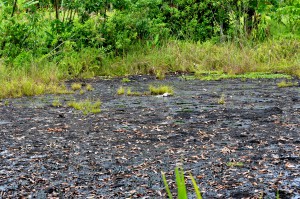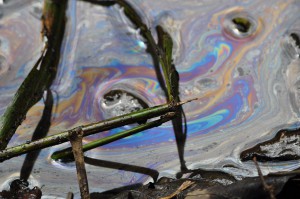Fabiola is a beautiful thirteen-year old girl with sparkling bright eyes and an infectious smile. As we approached her house in the village of Taracoa in Ecuador, she marched right over to us in her green t-shirt and rainbow flip flops, stuck out her hand in introduction – and shook each of ours vigorously. Her mother and grandmother followed more shyly, agreeing to sit and talk with us in the gathering dusk. This was day three of our trip to Ecuador to see first hand the impacts that Chevron’s oil extraction has had on the people and land here.
Before I arrived in Ecuador, I read about the terrible health problems that settlers and indigenous people living in the oil-affected area are experiencing. I knew about the toxic oil pits and the constant gas flaring. I knew that people were sick. But I wasn’t prepared for Fabiola. Fabiola was born with her heart on the wrong side of her body and doctors said that she would never walk. She proved them wrong on that count, but she is tiny for her age and she and her mother have had to make endless trips to doctors, sometimes traveling for days, to try and diagnose her many illnesses.
Fabiola’s grandmother moved to Taracoa twenty-three years ago, looking for land to farm. Texaco (now owned by Chevron) was already operating in the area, but the family didn’t know that the land they chose was right beside a toxic waste pit.  The oil company didn’t advertise the whereabouts of its disposal sites, and hundreds of people moved into the area to set up home, not realizing that they were settling in an area that was so profoundly polluted. Oil from the open waste pits has been seeping into groundwater and streams for decades, gradually contaminating all the potable water in an area the size of Rhode Island. Animals started to die and over time, people started falling sick at unusually high rates.
The oil company didn’t advertise the whereabouts of its disposal sites, and hundreds of people moved into the area to set up home, not realizing that they were settling in an area that was so profoundly polluted. Oil from the open waste pits has been seeping into groundwater and streams for decades, gradually contaminating all the potable water in an area the size of Rhode Island. Animals started to die and over time, people started falling sick at unusually high rates.
Fabiola’s mother told us that she used to tend to the cows close by their house when she was pregnant with her daughter. Most days she would spend walking around the oil pit, and drinking water from the family’s well. It smelt like crude oil, and had a constant film of oil floating on the top, but it was their only source of water.  Chevron/Texaco for their part assured residents of the area that the crude oil was actually good for them, encouraging people to rub it on their skin to treat arthritis. To this day Chevron claims that there is no connection between exposure to crude oil and human illness, an assertion that would be laughable if the effects were not so tragic.
Chevron/Texaco for their part assured residents of the area that the crude oil was actually good for them, encouraging people to rub it on their skin to treat arthritis. To this day Chevron claims that there is no connection between exposure to crude oil and human illness, an assertion that would be laughable if the effects were not so tragic.
Fabiola was born with severe birth defects just like many other children whose families live on the edge of Chevron’s oil sites. The company claims that they have cleaned up their mess, but one look at a ‘remediated site’ makes it abundantly clear that the so-called clean up is a cover up at best. There is very little that the residents of Taracoa can do to help the little ones like Fabiola who have already been so affected by Chevron’s legacy. Almost everyone buys their drinking and washing water these days, but money is scarce, and many can’t afford it. Their best hope of a long-terms solution lies in a court case that is being fought to hold the giant oil company accountable for cleaning up its mess once and for all, and for providing healthcare and clean water for all the many people who have suffered from Chevron/Texaco’s irresponsible waste dumping. The company has been fighting the case every step of the way. But I don’t think that any Chevron lawyer or executive who met Fabiola could fail to have a change of heart, and I hope with all of mine, that Chevron will ensure that hers is the last generation to suffer.